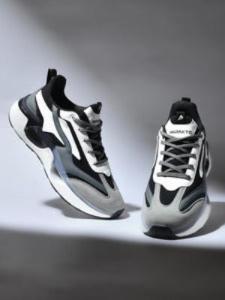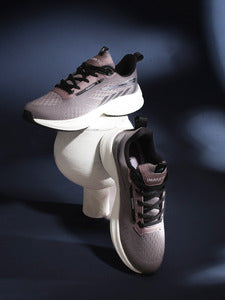How to Choose the Perfect Running Shoes in 2025: Expert Tips Inside!

If you've been wondering how to buy running shoes in 2025, it's understandable. Regardless of whether you're training for your very first marathon or are beginning a new fitness regimen, having the right shoes is essential to achieving the desired results.
Just like with many other products, running shoes also do not work with the phrase "one-size-fits-all." To maximize comfort and prevent injuries, running shoes must be tailored to the specific individual’s foot type, gait, running style, and terrain.
Why Choosing the Right Running Shoes Matters
Awful footwear can lead to injuries such as shin splints, knee pain, or back issues. On the other hand, the right choice can guarantee an improved experience, enhanced efficiency, and lighter joints.
As such, make sure to exercise caution when buying your running shoes in India or elsewhere, as the rules are the same universally.
1. Know Your Foot Type
Before diving into fancy features or colors, understand your foot structure. There are three basic foot types:
Low arches indicate Overpronation - opt for shoes featuring arch support and improved motion control. Neutral arch - Balanced pronation means you should select stability shoes offering diverse support.
High arches - Predominantly underprone? Reach for cushioned footwear that effectively absorbs shock.
Final piece of advice - run the “wet foot test.” Step on paper after wetting your foot and observe the imprint left behind.
2. Analyze Your Running Style
Are you a casual jogger, competitive sprinter, or trail runner?
Are you a light jogger, competitive runner, or do you prefer trail running?
Daily joggers: Seek out soft, tough shoes.
Long-distance runners: Go for lightweight cushioning.
Trail runners: Prioritize foot protection and grip.
Speed trainers: A responsive midsole with the least weight works best.
Think about how far you plan to run, how often you'll do it, and where to run.
3. Choose the Right Cushioning
Cushioning is critical to shock absorbing, but it can get out of hand quickly.
Less cushion: Feels more natural and relies on foot mechanics.
Maximum cushion: Plentiful comfort suited for long runs or recovery days.
Too much foam is not ideal when attempting to perform well. Finding balance outperforms the need for excessive cushioning.
4. Understand Heel Drop
Heel drop is the difference in cushioning from heel to forefoot, which can impact running form and how the runner strikes the ground.
0-4mm: Strikers will find a midfoot or forefoot strike, which favours experienced runners.
5-8mm: Balanced and fits most styles.
10-12mm: Cushioned heavily at the heel to help heel strikers and beginners.
Ease into it if you’re new, then test your limits gradually, swapping styles to support your natural gait.
5. Prioritize Fit & Comfort
How advanced a shoe is does not matter because if it doesn’t feel right, it is not right for you.
Perfect form entails:
Plenty of room in the toe box.
A snug fit in the midfoot (not tight).
Heel locked in with no slipping.
Always wear your running socks and try both shoes. Take a few steps or jog a couple of them to test.
Your feet swell throughout the day, which is why it is best to shop for running shoes in the evening and at the right time to get the most accurate fit.
6. Think About Terrain
Selecting the optimal footwear for runners depends on the location you will be running in as well:
Shoes for road running: These need to be light, comfortable, and equipped with proper ventilation.
Shoes for trail running: Should provide additional grip, have sturdy construction, and defend against shards.
Treadmill shoes: Must be well-cushioned and lightweight.
7. Replace Shoes Regularly
Even the best shoes wear out. On average, you should replace your running shoes every 500–800 km (or every 4–6 months if you run regularly).
Signs it’s time for a new pair:
-
Uneven wear on the sole
-
Decreased cushioning
-
Increased joint pain or discomfort post-run
8. Consider Brand and Budget
In 2025, options are endless. From top-tier global brands to emerging running shoes in India, you can find excellent quality in every price range.
You don’t need to break the bank, but avoid super-cheap knockoffs. Invest in value, not just price.
FAQs: How to Choose Running Shoes
1. How do you pick running shoes for flat feet?
In case you have flat feet, you are at risk of overpronation. Go for motion control or stability shoes with a strong arch; these will aid in injury prevention and alignment correction.
2. What is heel drop in shoes?
Heel drop is the height difference between the toe box and the heel of the shoe. A higher drop helps those who strike with their heels (10-12 mm) while a lower drop promotes natural stride and forefoot striking (0-4 mm).
3. Are cushioned shoes good for running?
Yes, but it depends on your needs. Cushioned shoes are good for novice and long-distance runners as they provide comfort and absorb shocks. However, experienced runners may want less cushioning to feel the ground better.
4. Which are the best shoes for runners in India?
Asics, Puma, Nike, and Adidas all feature the best running shoes available in India, but bear in mind that the best shoe is the one that supports your running objectives, matches your gait, and fits your feet.
5. Do running shoes make a difference?
Absolutely. Having the right shoes makes a runner perform better, recover faster, and sustain fewer injuries. The importance of good shoes cannot be taken for granted in any workout routine.



